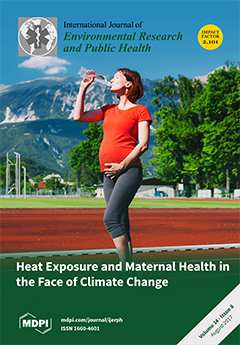This research analyzed the relationship between extreme heat and Emergency Medical Service (EMS) calls in King County, WA, USA between 2007 and 2012, including the effect of community-level characteristics. Extreme heat thresholds for the Basic Life Support (BLS) data and the Advanced Life
[...] Read more.
This research analyzed the relationship between extreme heat and Emergency Medical Service (EMS) calls in King County, WA, USA between 2007 and 2012, including the effect of community-level characteristics. Extreme heat thresholds for the Basic Life Support (BLS) data and the Advanced Life Support (ALS) data were found using a piecewise generalized linear model with Akaike Information Criterion (AIC). The association between heat exposure and EMS call rates was investigated using a generalized estimating equations with Poisson mean model, while adjusting for community-level indicators of poverty, impervious surface, and elderly population (65+). In addition, we examined the effect modifications of these community-level factors. Extreme-heat thresholds of 31.1 °C and 33.5 °C humidex were determined for the BLS and ALS data, respectively. After adjusting for other variables in the model, increased BLS call volume was significantly associated with occurring on a heat day (relative rate (RR) = 1.080,
p < 0.001), as well as in locations with higher percent poverty (RR = 1.066,
p < 0.001). No significant effect modification was identified for the BLS data on a heat day. Controlling for other variables, higher ALS call volume was found to be significantly associated with a heat day (RR = 1.067,
p < 0.001), as well as in locations with higher percent impervious surface (RR = 1.015,
p = 0.039), higher percent of the population 65 years or older (RR = 1.057,
p = 0.005), and higher percent poverty (RR = 1.041,
p = 0.016). Furthermore, percent poverty and impervious surface were found to significantly modify the relative rate of ALS call volumes between a heat day and non-heat day. We conclude that EMS call volume increases significantly on a heat day compared to non-heat day for both call types. While this study shows that there is some effect modification between the community-level variables and call volume on a heat day, further research is necessary. Our findings also suggest that with adequate power, spatially refined analyses may not be necessary to accurately estimate the extreme-heat effect on health.
Full article





